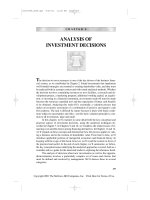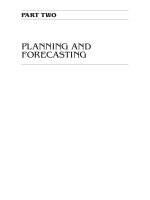Lecture Database security and auditing - Protecting data integrity and accessibility - Chapter 8: Application Data Auditing
Bạn đang xem bản rút gọn của tài liệu. Xem và tải ngay bản đầy đủ của tài liệu tại đây (339.97 KB, 37 trang )
Database Security and
Auditing: Protecting Data
Integrity and Accessibility
Chapter 8
Application Data Auditing
Objectives
•
•
•
•
Understand the difference between the auditing
architecture of DML Action Auditing Architecture
and DML changes
Create and implement Oracle triggers
Create and implement SQL Server triggers
Define and implement Oracle fine-grained
auditing
Database Security and Auditing
2
Objectives (continued)
•
•
•
Create a DML statement audit trail for Oracle
and SQL Server
Generate a data manipulation history
Implement a DML statement auditing using a
repository
Database Security and Auditing
3
Objectives (continued)
•
•
Understand the importance and the
implementation of application errors auditing in
Oracle
Implement Oracle PL/SQL procedure
authorization
Database Security and Auditing
4
DML Action Auditing Architecture
•
•
Data Manipulation Language (DML): companies
use auditing architecture for DML changes
DML changes can be performed on two levels:
–
–
•
Row level
Column level
Fine-grained auditing (FGA)
Database Security and Auditing
5
DML Action Auditing Architecture
(continued)
Database Security and Auditing
6
DML Action Auditing Architecture
(continued)
Database Security and Auditing
7
Oracle Triggers
•
Stored PL/SQL procedure executed whenever:
–
–
•
•
DML operation occurs
Specific database event occurs
Six DML events (trigger timings): INSERT,
UPDATE, and DELETE
Purposes:
–
–
Audits, controlling invalid data
Implementing business rules, generating values
Database Security and Auditing
8
Oracle Triggers (continued)
Database Security and Auditing
9
Oracle Triggers (continued)
•
•
CREATE TRIGGER
Executed in a specific order:
–
–
•
•
STATEMENT LEVEL triggers before COLUMN
LEVEL triggers
BEFORE triggers before AFTER triggers
USER_TRIGGERS data dictionary view: all
triggers created on a table
A table can have unlimited triggers: do not
overuse them
Database Security and Auditing
10
Oracle Triggers (continued)
Database Security and Auditing
11
SQL Server Triggers
•
•
CREATE TRIGGER DDL statement: creates a
trigger
Trigger condition:
–
–
•
Prevents a trigger from firing
UPDATE() and COLUMNS_UPDATE() functions
Logical tables:
–
–
DELETED contains original data
INSERTED contains new data
Database Security and Auditing
12
SQL Server Triggers (continued)
•
Restrictions—Transact-SQL statements not
allowed:
–
–
–
–
–
–
–
ALTER and CREATE DATABASE
DISK INIT and DISK RESIZE
DROP DATABASE and LOAD DATABASE
LOAD LOG
RECONFIGURE
RESTORE DATABASE
RESTORE LOG
Database Security and Auditing
13
Implementation of an Historical Model
with SQL Server
•
Create a history table:
–
–
•
Same structure as original table
HISTORY_ID column
Create a trigger: inserts original row into the
HISTORY table
Database Security and Auditing
14
Fine-grained Auditing (FGA) with
Oracle
•
•
Oracle provides column-level auditing: Oracle
PL/SQL-supplied package DBMS_FGA
DBMS_FGA procedures:
–
–
–
–
ADD_POLICY
DISABLE_POLICY
DROP_POLICY
ENABLE_POLICY
Database Security and Auditing
15
Fine-grained Auditing (FGA) with
Oracle (continued)
•
ADD_POLICY parameters:
–
–
–
–
–
–
OBJECT_SCHEMA
OBJECT_NAME
POLICY_NAME
AUDIT_CONDITION
AUDIT_COLUMN
HANDLER_SCHEMA
Database Security and Auditing
16
Fine-grained Auditing (FGA) with
Oracle (continued)
•
ADD_POLICY parameters (continued):
–
–
–
•
HANDLER_MODULE
ENABLE
STATEMENT_TYPES
DBA_FGA_AUDIT_TRAIL: view the audit trail
of the DML activities
Database Security and Auditing
17
DML Action Auditing with Oracle
•
Record data changes on the table:
–
–
–
•
Name of the person making the change
Date of the change
Time of the change
Before or after value of the columns are not
recorded
Database Security and Auditing
18
DML Action Auditing with Oracle
(continued)
Database Security and Auditing
19
DML Action Auditing with Oracle
(continued)
•
Steps:
–
–
–
–
–
Use any user other than SYSTEM or SYS; with
privileges to create tables, sequences, and
triggers
Create the auditing table
Create a sequence object
Create the trigger that will record DML
operations
Test your implementation
Database Security and Auditing
20
History Auditing Model Implementation
Using Oracle
•
•
Historical data auditing is simple to implement;
main components are TRIGGER objects and
TABLE objects
Keeps record of:
–
–
Date and time the copy of the record was
captured
Type of operation applied to the record
Database Security and Auditing
21
History Auditing Model Implementation
Using Oracle (continued)
•
Steps:
–
–
–
–
Use any user other than SYSTEM or SYS; with
privileges to create tables, sequences, and
triggers
Create history table
Create the trigger to track changes and record
all the values of the columns
Test your implementation
Database Security and Auditing
22
DML Auditing Using Repository with
Oracle (Simple 1)
•
•
•
Simple Auditing Model 1
Flag users, tables, or columns for auditing
Requires less database administrative skills:
–
–
•
•
Application administrators can do it
User interface is built in top of the repository
Auditing flags are flexible
Does not record before or after column values;
only registers type of DML operations
Database Security and Auditing
23
DML Auditing Using Repository with
Oracle (Simple 1) (continued)
Database Security and Auditing
24
DML Auditing Using Repository with
Oracle (Simple 1) (continued)
•
Steps:
–
–
–
–
–
Use any user other than SYSTEM or SYS
Create triggers
Create sequence object
Build tables to use for applications
Populate application tables
Database Security and Auditing
25









